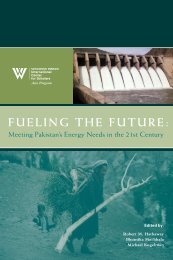Environmental Change and Security Project Report - Woodrow ...
Environmental Change and Security Project Report - Woodrow ...
Environmental Change and Security Project Report - Woodrow ...
You also want an ePaper? Increase the reach of your titles
YUMPU automatically turns print PDFs into web optimized ePapers that Google loves.
work’s effects vary across time <strong>and</strong> space; <strong>and</strong><br />
the capacity to promote change is distributed<br />
unequally among states <strong>and</strong> non-state actors.<br />
<strong>Environmental</strong> security (ES) scholarship<br />
provides important theoretical <strong>and</strong> methodological<br />
underpinnings for the embryonic field<br />
examining these threat networks. ES literature<br />
introduced an interdisciplinary perspective into<br />
traditional security practice, promoted the<br />
incorporation of security issues into mainstream<br />
endeavors like business <strong>and</strong> engineering,<br />
<strong>and</strong> explored the interactive dynamics of the<br />
diverse human <strong>and</strong> natural networks that constitute<br />
the modern world. While the ES field<br />
does not offer a suite of all-purpose solutions to<br />
transnational security challenges, it does provide<br />
useful analytical tools based on extensive<br />
research <strong>and</strong> debate. In addition, bringing<br />
together these fields can also help correct flaws<br />
in ES research, such as lack of engagement with<br />
the broader security community.<br />
The New <strong>Security</strong> L<strong>and</strong>scape:<br />
Networks of Threat <strong>and</strong><br />
Vulnerability<br />
Most of the planet’s terrain is now divided<br />
among 191 sovereign states, 2 many of which<br />
have achieved the security from internal conflict<br />
<strong>and</strong> external military aggression envisioned<br />
in Thomas Hobbes’ seminal 1651<br />
work, Leviathan. 3 For 300 years following<br />
1648’s Treaty of Westphalia, sovereign states<br />
aspired to self-sufficiency <strong>and</strong> viewed other<br />
states largely in terms of domination <strong>and</strong> balance.<br />
After World War II, however, these<br />
ideals were ab<strong>and</strong>oned in favor of the United<br />
Nations system of formally sovereign states<br />
constrained by international law <strong>and</strong> mutually<br />
beneficial trade relations. 4 Michael Doyle<br />
(1983) <strong>and</strong> other scholars have argued persuasively<br />
that a “liberal zone of peace” has<br />
emerged: liberal states are democratic, respect<br />
international law, <strong>and</strong> engage in trade. They<br />
fight non-democratic states but not each<br />
other, thus creating zones of peace.<br />
However, open democracy <strong>and</strong> trade have<br />
been a mixed blessing. Over the past several<br />
decades, the international <strong>and</strong> transnational<br />
networks linking states have grown more<br />
numerous <strong>and</strong> more sophisticated, propelled by<br />
rapid technological innovation <strong>and</strong> diffusion<br />
(Zacher, 1992). These networks have generated<br />
wealth, knowledge, power, <strong>and</strong> cooperation in<br />
ways that have improved the lives <strong>and</strong> enhanced<br />
the security of millions of people. However,<br />
they have also introduced threats <strong>and</strong> vulnerabilities,<br />
ranging from old-fashioned religious<br />
extremism to modern computer viruses, by<br />
empowering non-state actors through unprecedented<br />
access to information, communication<br />
systems, <strong>and</strong> transportation, resulting in a technologically<br />
accelerated political condition that<br />
we describe as “hyper-medievalism.”<br />
Rather than aggregating political <strong>and</strong> economic<br />
power within a defined territory, a<br />
hyper-medieval world is highly decentralized.<br />
Multiple stakeholders—from warlords to business<br />
cartels—compete effectively with states,<br />
which may fail due to corruption or ineffective<br />
law enforcement. Technology has reduced barriers<br />
to power accumulation, accelerating the<br />
start-up phase for new power-holders <strong>and</strong><br />
injecting high levels of turbulence into the<br />
global system (Rosenau, 1990). Speed, knowledge,<br />
mobility, <strong>and</strong> reach are great assets for<br />
legitimate businesses <strong>and</strong> scientific research<br />
projects—but also for drug traffickers, timber<br />
mafias, human smugglers, terrorists, <strong>and</strong> identity<br />
thieves.<br />
Transnational networks are not easily dismantled<br />
or neutralized. Investigative reports<br />
by PBS <strong>and</strong> ABC concluded that the war on<br />
drugs has placed 1.5 million Americans in<br />
prison <strong>and</strong> cost hundreds of billions of tax dollars,<br />
<strong>and</strong> yet it has not made a dent in the production,<br />
transportation, sale, or use of illegal<br />
drugs, which is valued at $300 billion to $400<br />
billion a year (Schaffer, n.d.; Frontline, 2000;<br />
Stossel, 2002). As soon as one trafficker is<br />
arrested, another steps in; when pressure is<br />
applied to one country, production moves to<br />
another; <strong>and</strong> vast sums of money breed corruption<br />
in law enforcement at home <strong>and</strong><br />
abroad. After 30 years of war, the enemy—the<br />
transnational network of drug traffickers—is<br />
37<br />
COMMENTARY • THE NEXT STEPS FOR ENVIRONMENT, POPULATION, AND SECURITY

















